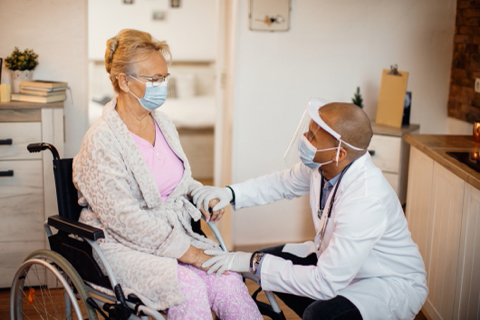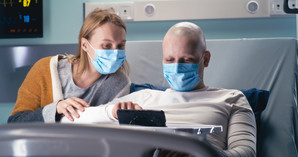| June 15, 2021, Issue #768 In 2017, paid sick leave was available to 84 percent of workers at large firms (500 or more employees) compared with 77 percent at midsize firms (50–499 employees) and 55 percent at small firms (49 or fewer employees). (Source: AHRQ, Medical Expenditure Panel Survey Research Findings #47, Prevalence of Paid Sick Leave Among Wage Earners, 2017.)  Increased exposure to patient monitoring alarms is associated with significant increases in nurse workload that may lead to missed patient care tasks and potential harm, according to an AHRQ-funded study published in Hospital Pediatrics. A tertiary care children's hospital participated in a Patient Safety Learning Laboratory funded by AHRQ that aimed to reduce noninformative alarms and accelerate nurses' response to critical events. The study found that nurses exposed to 40 or more alarms within a two-hour period experienced a 5.5 point increase in workload as measured by the National Aeronautics and Space Administration's Task Load Index scale. Adverse outcomes associated with increased high alarm counts include missed delivery of care, poor nurse-patient communication, infection and death. Researchers concluded that reducing nonactionable alarms should be a high priority to improve patient safety. Access the study abstract. |  AHRQ's new Personal Protective Equipment (PPE) COVID-19 Observational Audit Data Tracking Tool helps nursing home staff compile and track data on PPE use. The preprogrammed Excel workbook collects PPE audit data and identifies patterns of use and efforts to improve PPE compliance. An accompanying user guide provides detailed, step-by-step instructions for recording PPE observations quickly and accurately, leads staff members through the data entry process and provides narrative directions and screen-capture visuals. Access the tool and user guide as well as other resources aimed at preventing the spread of COVID-19 |  An AHRQ data analysis of 720 cancer survivors found that more than half reported receiving support from an informal caregiver, most frequently a spouse or child. The study, based on data from AHRQ's Medical Expenditure Panel Survey, showed female survivors and survivors who were married were nearly 10 percentage points more likely to receive help from an informal caregiver than male or unmarried patients, respectively. People who were White/non-Hispanic were over 12 percentage points less likely to report having an informal caregiver than people of a race/ethnicity other than White. The study population included cancer survivors who were treated for cancer within the past three years. Access the abstract of the study, which was published in Cancer. | AHRQ has developed a new tool to help primary care practices screen and refer patients to address their unmet social needs, such as access to adequate food and housing. The resource aligns with agency efforts to help practices provide care that takes into account social determinants of health. It is included among the agency's Tools for Change, a set of resources developed as part of AHRQ's EvidenceNOW: Advancing Heart Health Initiative. The tool helps practices find resources on patient screening and referral, consider what approaches work best for their practice and understand how to use collected information to address patients' social needs, tailor their care and maximize reimbursement. AHRQ's Patient Safety Network (PSNet) highlights journal articles, books and tools related to patient safety. Articles featured this week include: Review additional new publications in PSNet's current issue or access recent cases and commentaries in AHRQ's WebM&M (Morbidity and Mortality Rounds on the Web). • Systematic review: Prehospital Airway Management
• Systematic review: Radiation Therapy for Brain Metastases | AHRQ in the Professional Literature Experiences applying technology to overcome common challenges in pharmacy practice-based research in the United States. Gernant SA, Adeoye-Olatunde OA, Murawski MM, et al. Pharmacy. 2020 May 30;8(2):93. Access the abstract on PubMed®. Nationwide qualitative study of practice leader perspectives on what it takes to transform into a patient-centered medical home. Qureshi N, Quigley DD, Hays RD. J Gen Intern Med. 2020 Dec;35(12):3501-9. Epub 2020 Aug 3. Access the abstract on PubMed®. Electronically available patient claims data improve models for comparing antibiotic use across hospitals: results from 576 U.S. facilities. Goodman KE, Pineles L, Magder LS, et al. Clin Infect Dis. 2020 Aug 5. [Epub ahead of print.] Access the abstract on PubMed®. Height of fever and invasive bacterial infection. Michelson KA, Neuman MI, Pruitt CM, et al. Arch Dis Child. 2021 Jun;106(6):594-6. Epub 2020 Aug 20. Access the abstract on PubMed®. Hospital-physician integration and Medicare's site-based outpatient payments. Post B, Norton EC, Hollenbeck B, et al. Health Serv Res. 2021 Feb;56(1):7-15. Access the abstract on PubMed®. Utilization and functional outcomes among Medicare home health recipients varied across living situations. Wang J, Ying M, Temkin-Greener H, et al. J Am Geriatr Soc. 2021 Mar;69(3):704-10. Epub 2020 Dec 3. Access the abstract on PubMed®. A systematic review of surveys for measuring patient-centered care in the hospital setting. Handley SC, Bell S, Nembhard IM. Med Care. 2021 Mar;59(3):228-37. Access the abstract on PubMed®. Pediatric ambulatory central line-associated bloodstream infections. Rinke ML, Heo M, Saiman L, et al. Pediatrics. 2021 Jan;147(1). Epub 2020 Dec 18. Access the abstract on PubMed®. Contact Information For comments or questions about AHRQ News Now, contact Bruce Seeman, (301) 427-1998 or Bruce.Seeman@ahrq.hhs.gov. |






No comments:
Post a Comment